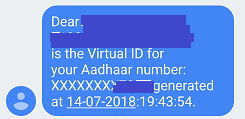 |
| Image credit: twitter.com/UIDAI |
Aadhaar Virtual ID (VID) is a temporary, revocable
16-digit random number generated against your Aadhaar. If you don’t want to
share your Aadhaar number, you can use VID in place of Aadhaar number for authentication
or e-KYC services.
The Aadhaar Virtual ID may be used for authentication services in the similar way the Aadhaar is used. This way VID eliminates the requirement of Aadhaar number at the time of authentication. Moreover, Aadhaar number can’t be retrieved from Aadhaar Virtual ID. In this post, let's take a look at how to generate VID.
Features of Aadhaar Virtual ID
1. The VID is a 16-digit random number
mapped with Aadhaar.
2. It can be used in lieu of
Aadhaar number at the time of authentication.
3. Aadhaar Virtual ID is temporary and can be
changed at any time.
4. VID can only be generated by Aadhaar card holder.
4. VID can only be generated by Aadhaar card holder.
5. Although it is mapped with Aadhaar number it is not possible to derive Aadhaar number from it.
6. You can regenerate it multiple
times.
7. Your VID will be valid
till the time a new VID is generated by you.
8. At any given time only
one VID will be valid for an Aadhaar number.
9. Your VID will be sent to the registered mobile
number via SMS.
10. Your consent is required for VID
based authentication or e-KYC services.
11. It is not mandatory to
generate your VID.
12. Presently, VID
generation facility is available on UIDAI's resident portal.
13. Agency is
not authorized to store VID in any database.
14. If you opt for retrieval of VID, the
last active VID will be sent to you.
How to Generate Aadhaar Virtual ID?
Aadhaar Virtual ID can be generated only by the Aadhaar number holder. The
entire process of generating a VID is
very easy. Presently, VID generation facility is available on UIDAI's resident
portal.
You can use this facility if you have your mobile number registered in the Aadhaar database. Once VID is generated from the UIDAI website, it will be sent to the registered mobile number via SMS.
Below is the step by step procedure to generate Virtual ID.
You can use this facility if you have your mobile number registered in the Aadhaar database. Once VID is generated from the UIDAI website, it will be sent to the registered mobile number via SMS.
Below is the step by step procedure to generate Virtual ID.
1. Visit the UIDAI’s official website
(uidai.gov.in).
3. Click “OK” on the pop-up.
Once you click on the pop-up, it will take you to VID Generation page.
5. You will receive the OTP on
your mobile number registered with Aadhaar database.
6. Enter the OTP.
7. Select the option to
generate a new VID or retrieve an old VID that you have already generated.
8. After selecting an option, click on “Submit” button.
9. Once complete, a message
will be displayed on your screen as “Congratulations! Your VID Number
Successfully Generated and sent to your registered mobile”.
10. You will receive 16-digits
Aadhaar Virtual ID along with last four digits of your Aadhaar on your mobile
number via SMS as shown in the image below.
Re-generation of VID
A new VID
will be generated on your request after the minimum validity period (currently
set as 1 day). The existing VID will be deactivated. If you want the retrieval
of your VID, the last active VID will be sent to your registered mobile.
Expiry
period of VID
Currently, there is no expiry period defined for Aadhaar Virtual ID. Your VID will
remain valid till the time a new VID is generated by you.
Also read: How to apply for Aadhaar card?
Also read: Aadhaar card download | E-Aadhaar download
Also read: How to download Aadhaar update history?
If you liked this article, share it with your friends and colleagues through social media. Your opinion matters, please share your comments.






Very Very Useful Article and Very Simply Laid Out.
ReplyDeleteThanks for the info. Very useful
ReplyDeleteThanks !
DeleteThis service is really very helpful and necessary, did not have any idea about it, thanks for the details.
ReplyDeleteI am glad you find it helpful.
Delete